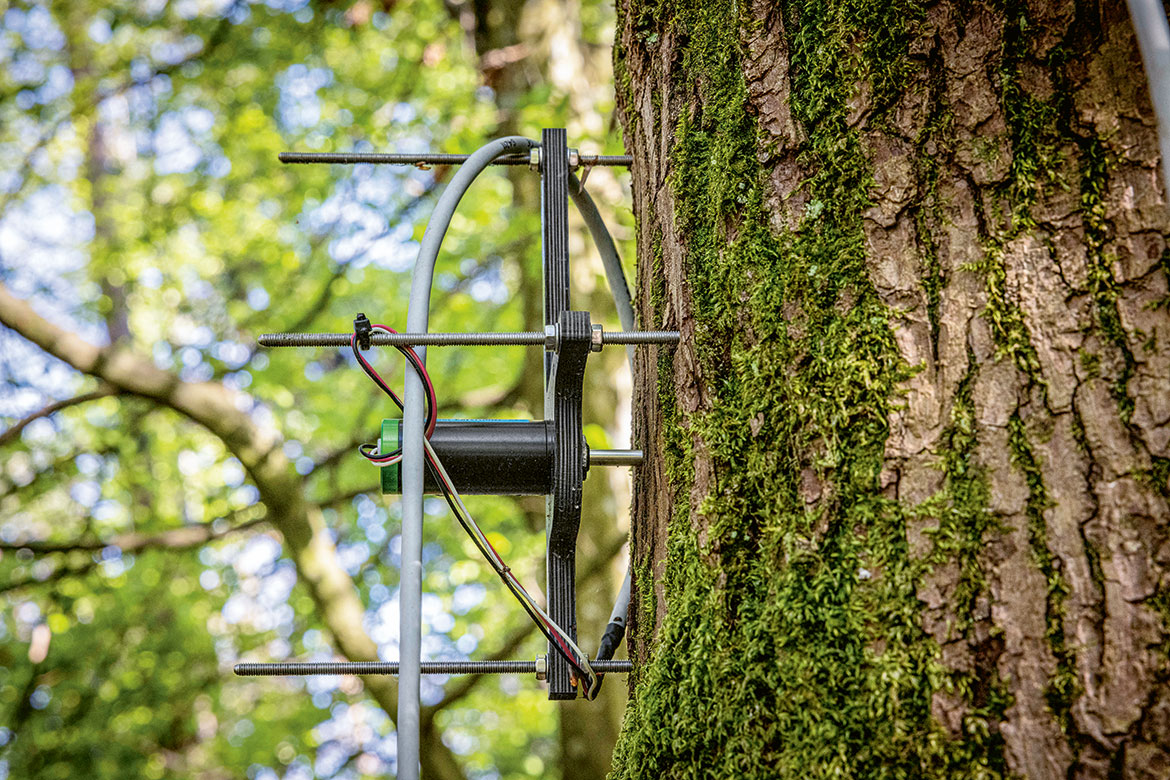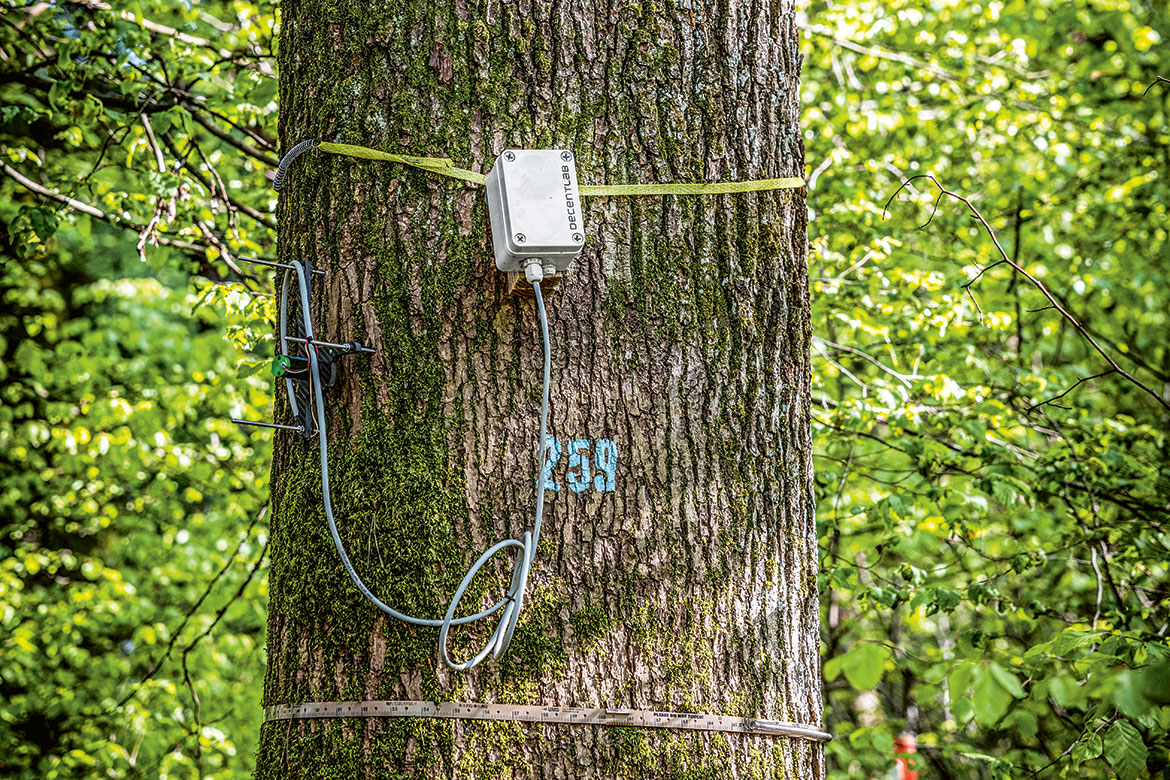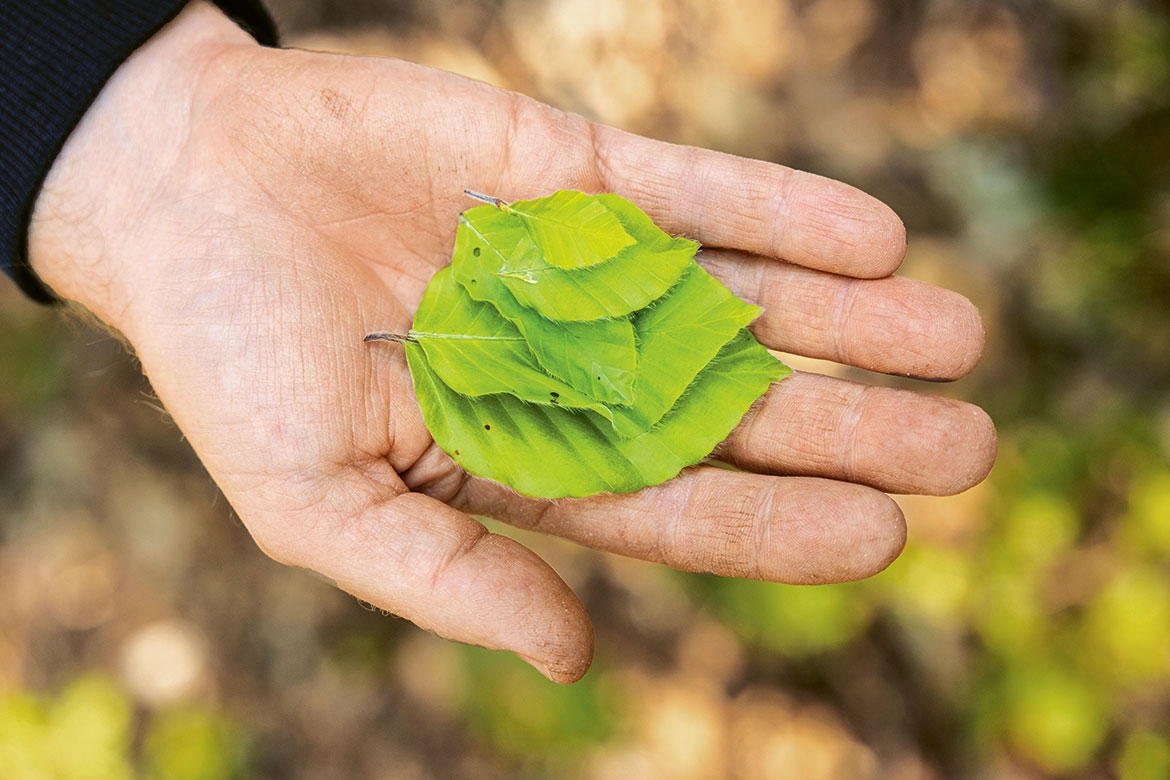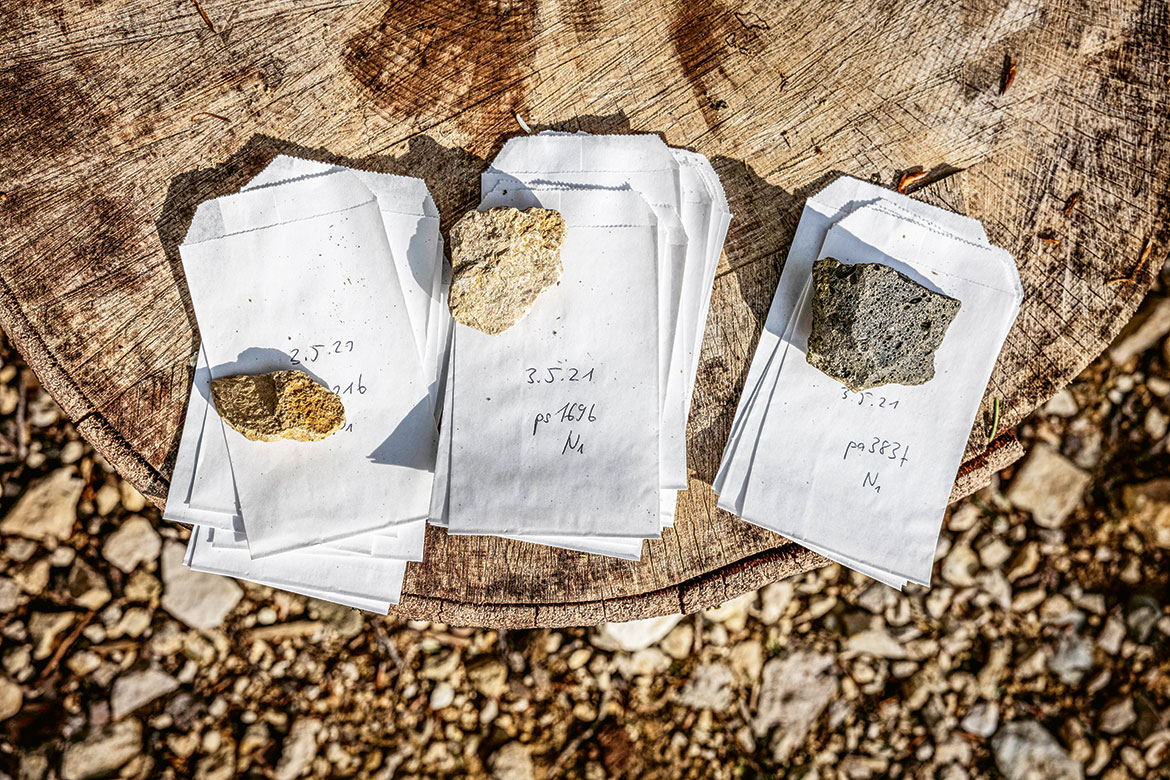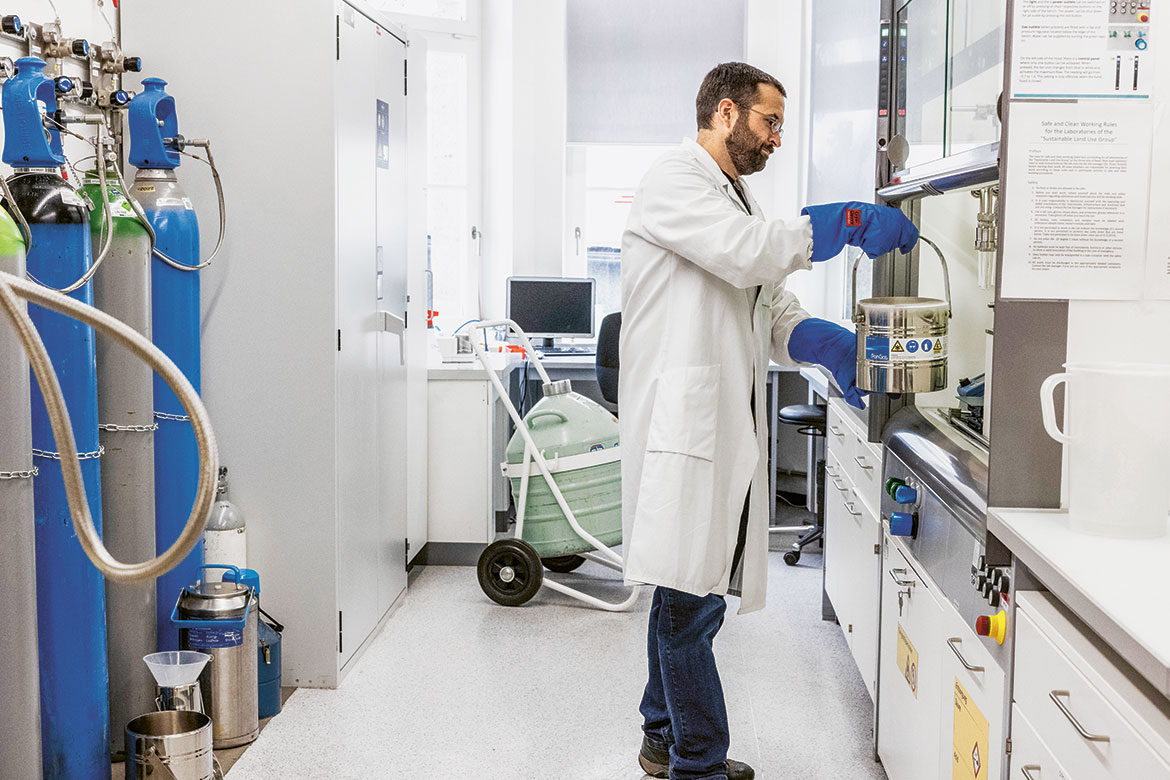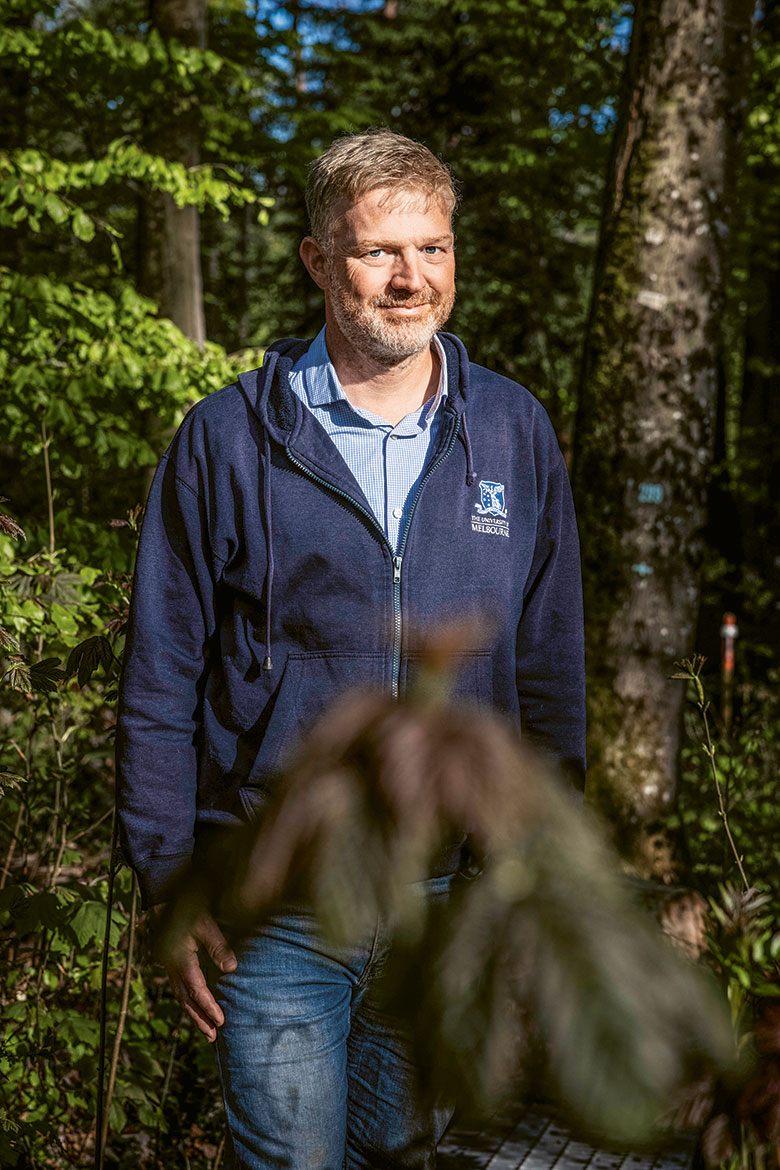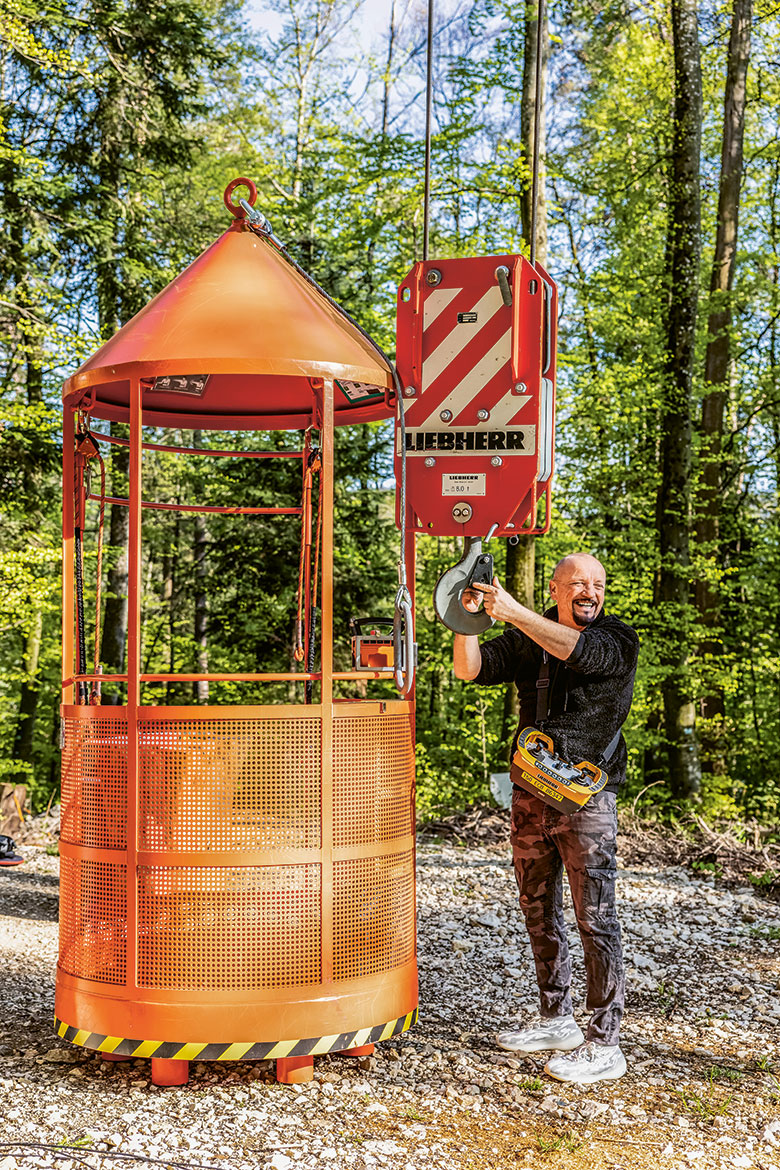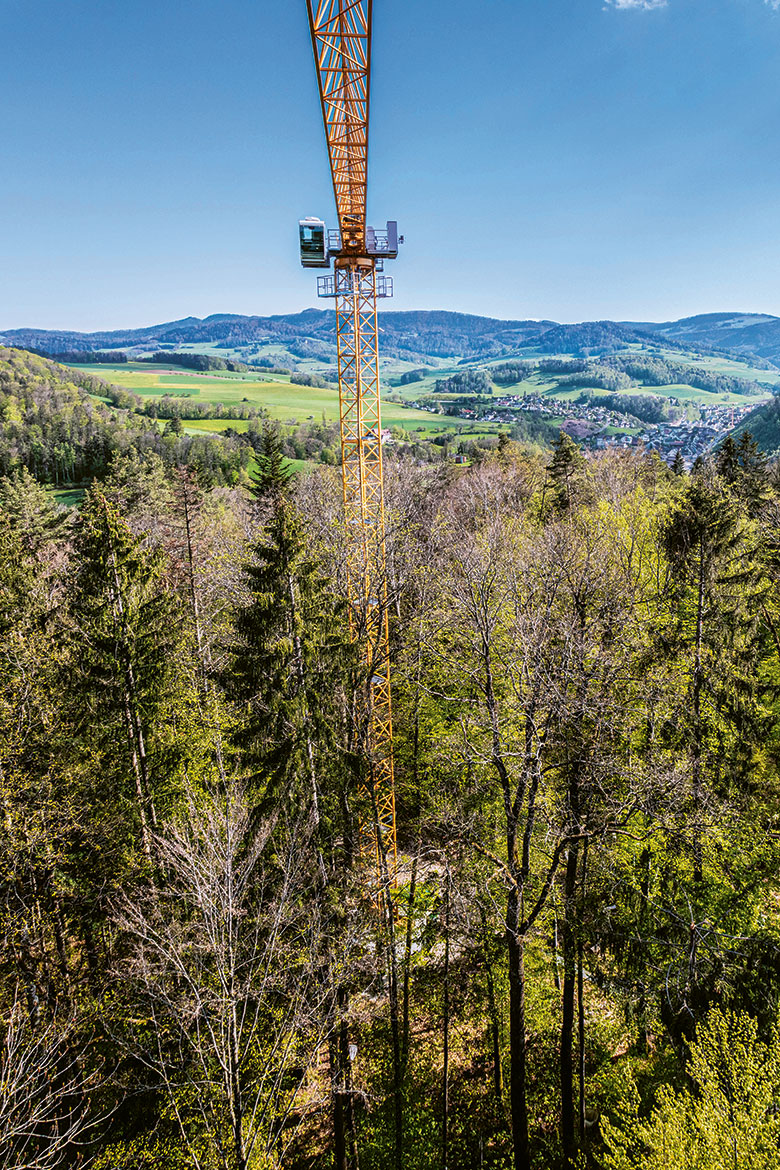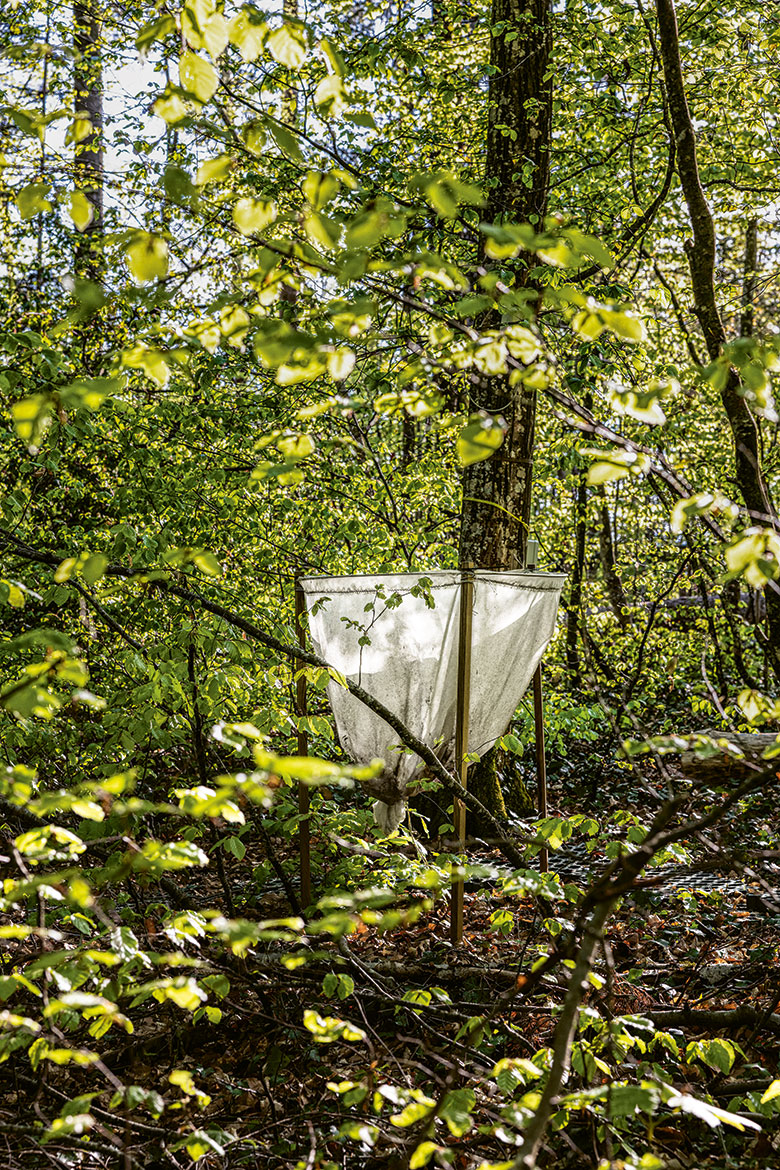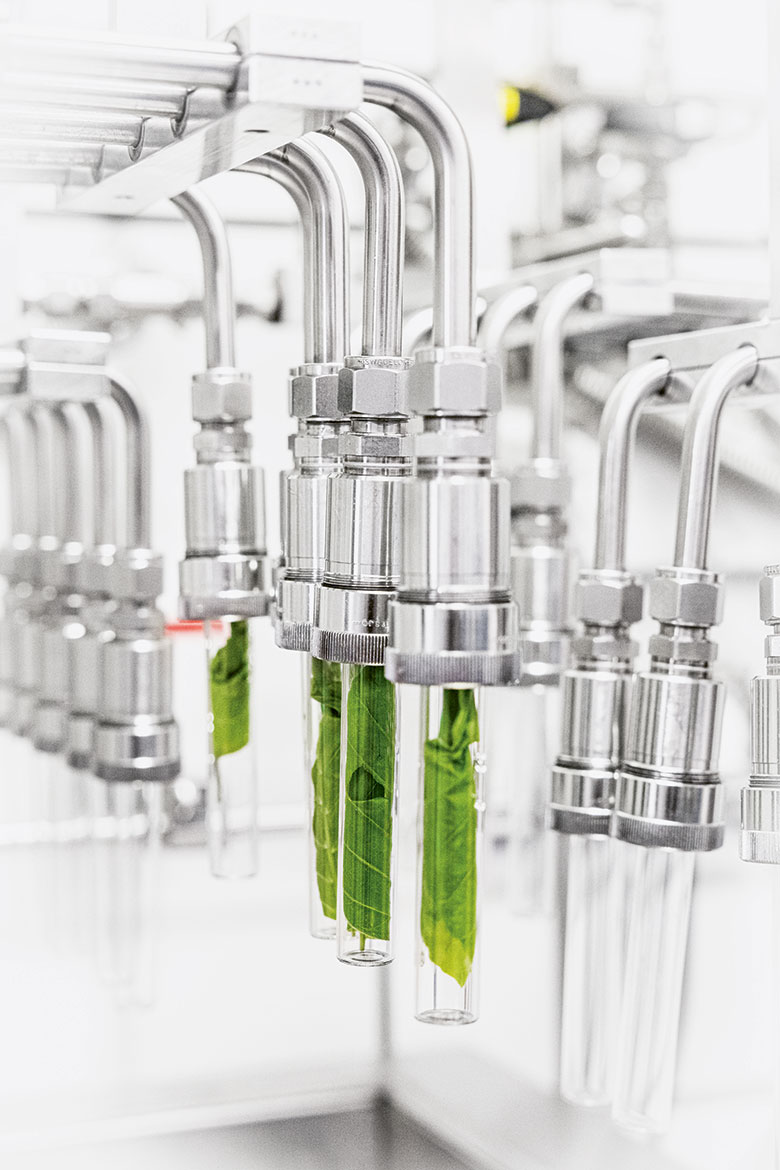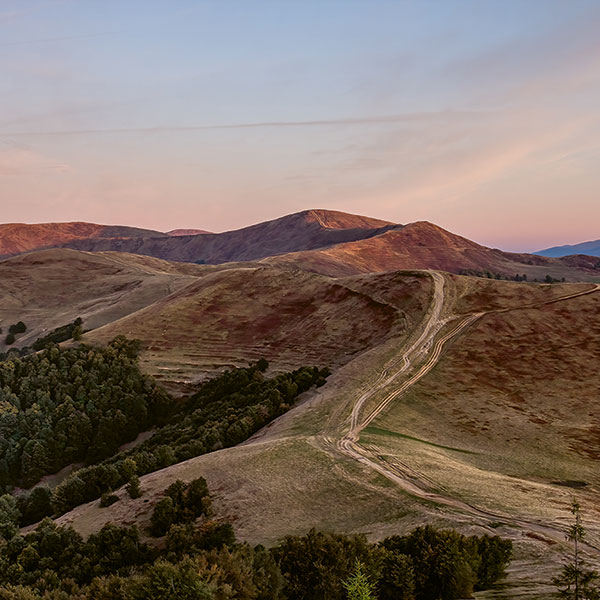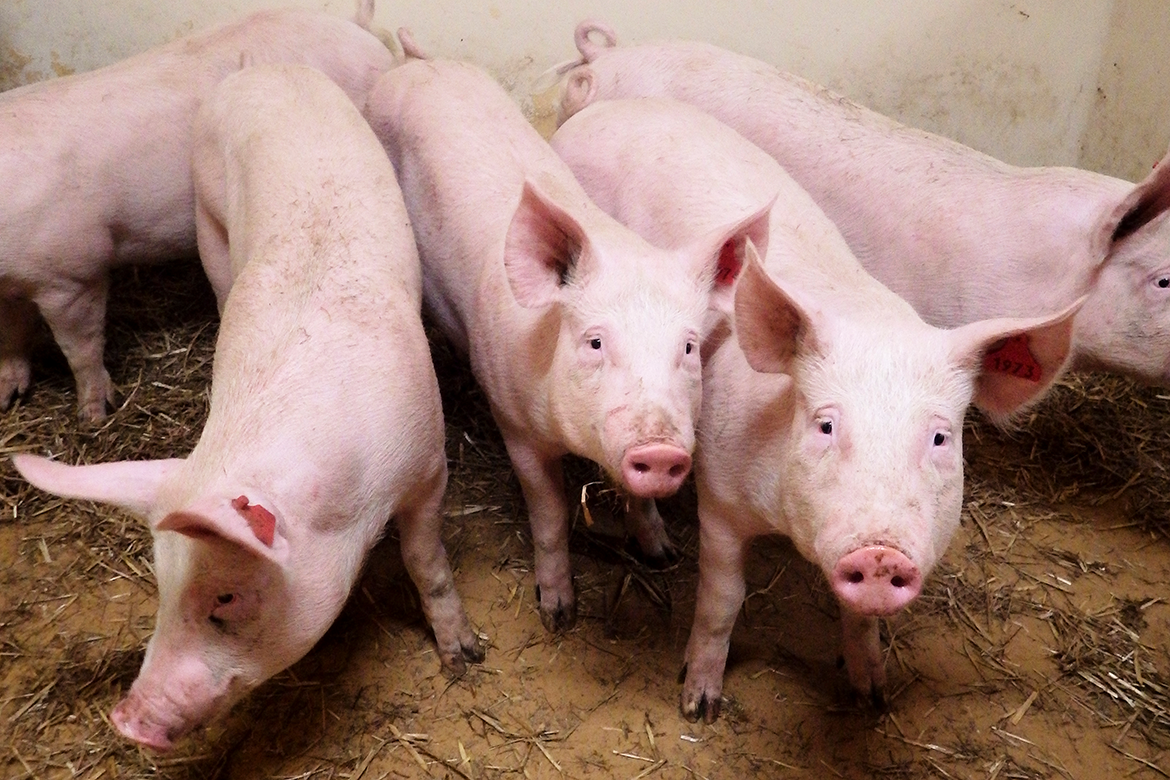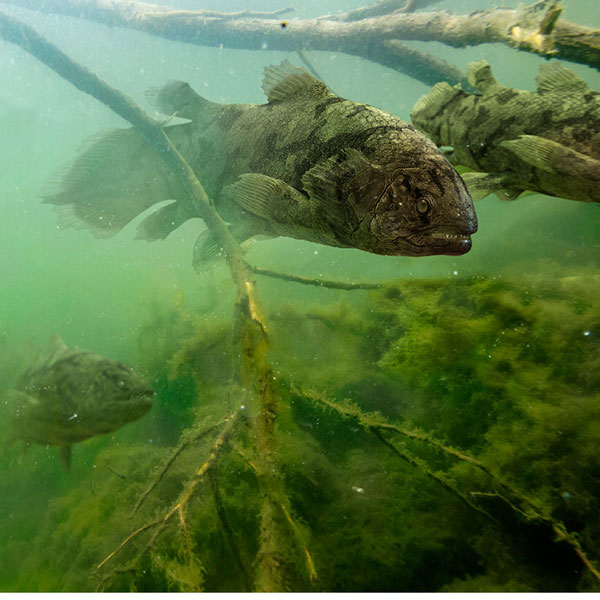REPORT
Investigating drought damage from the air
Researchers are hovering high above Europe’s most biodiverse forest laboratory to investigate how trees are coping with climate change and increasing aridity. Their results can help foresters to promote drought-resistant species.
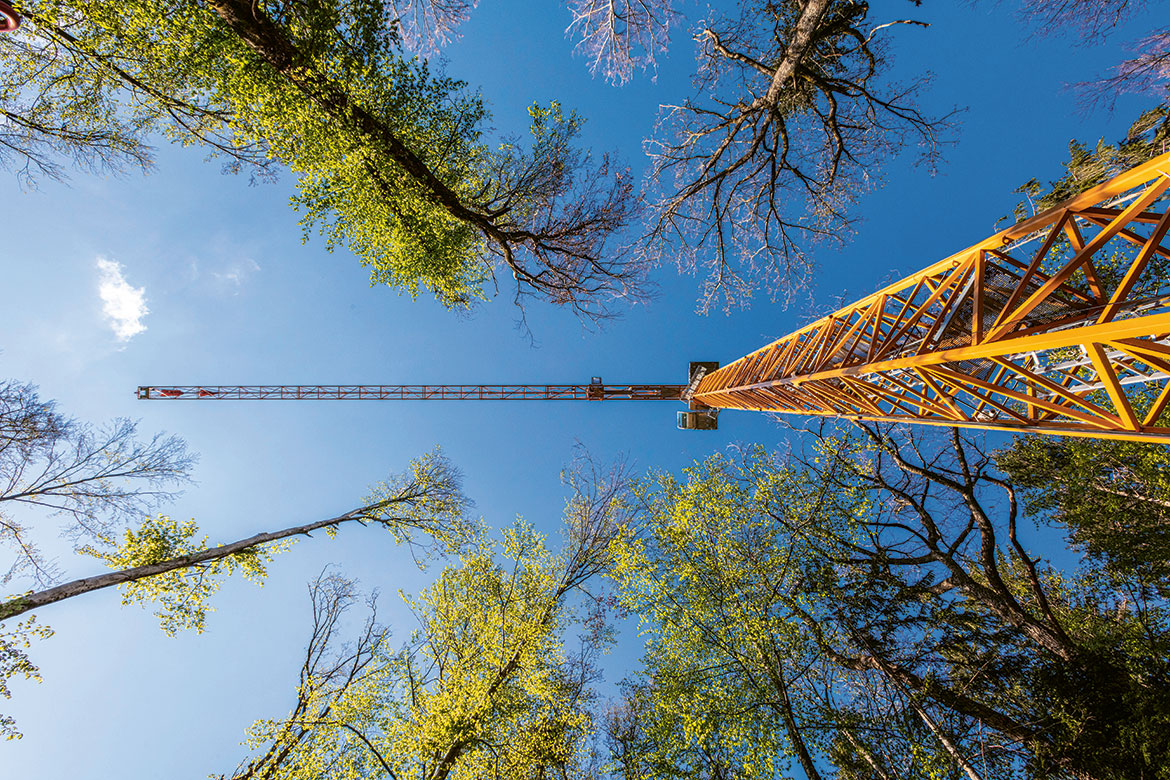
From 46 metres up, the researchers can get a good view of the state of the forest. | Image: Vera Hartmann
The crane operator André Kühne presses on a button, and a round iron basket rises up from the ground and moves straight upwards, past tree trunks and the crowns of pines, spruce, beech and oak, ever upwards, high above the treetops. We’re in a forested area near Hölstein in the canton of Basel-Landschaft. And his crane is carrying people, not building materials. His metal basket enables researchers to rise some 46 metres above the ground and hover over the treetops. Today, the man in the basket is Ansgar Kahmen, a biologist and professor for physiological plant ecology at the University of Basel. This facility is part of a research project that the University has been running for the past 20 years. On a fenced-off surface of 1.6 hectares – somewhat bigger than two soccer pitches – Kahmen and his team are investigating how the trees are coping with climate change. They aim to find out how different species of tree react to dry periods, whether they can adapt – and if so, how – and what our forests might look like in future.
To this end, the researchers have installed a whole arsenal of measuring devices in this part of the forest. They include weather stations, ground sensors, 70 so-called dendrometers that measure the trunk circumference of trees precisely down to the nearest millimetre, and 30 fabric funnels that catch falling foliage so that the researchers can then calculate the volume of leaves in the whole area. The building crane is standing here so that the researchers can investigate the trees from above. If they are going to understand the trees properly, and recognise whether or not they are suffering from disease or aridity, they have to be able to analyse the needles and leaves of the highest treetops. The crane helps them to reach the tops of some 200 trees.
Diagnosing treetops
The metal basket is now hovering above the canopy where the trees are bathed in sunlight. A plastic ribbon of red and white is fluttering from the top of a nearby spruce tree. A little farther away, two more such ribbons are attached to other trees. “This is so we can find these trees easily again”, says Kahmen. Every month, members of his team ascend to collect samples of twigs and leaves from the treetops. Altogether, they are carrying out measurements on nine different species up here. For example, they are analysing how much CO2 the trees are absorbing. The researchers have chosen an especially biodiverse section of the forest for their long-term project. Besides the usual suspects of spruce, fir and beech, this area also offers oak, hornbeam and checker tree, all growing close to one another. Kahmen’s researchers then take the samples they’ve collected back to their lab to analyse them, measuring the thickness and surface area of the leaves along with their nutrient levels. They also examine whether the conduits for water inside the wood are healthy or have been damaged by dryness. “Our samples enable us to determine which tree species are suffering from aridity, and which ones aren’t”, says Kahmen.
Pressure from drought
The 500 or so trees in their forest laboratory are facing mounting pressure today. From high up in the basket, Kahmen points to a gap among the treetops. “The heavy snowfall in January broke off the top of one of the trees here”, he explains. A little farther away, we can see a larger clearing. This is where whole rows of trees buckled during Storm Burglind (aka Eleanor) in January 2018. To the right we can see two firs whose trunks and needles are a rusty red and completely dried out. These trees are dead. Since the project began in 2013, this forest laboratory has lost ten percent of its trees to storms, bark beetles and drought. The hot summer of 2018 destroyed a high number of trees, especially spruce. That extreme event nevertheless allowed the researchers to make important findings. Their measuring devices enabled them to follow in real time how the trees reacted to a shortage of water, and they also observed what mechanisms cause the trees to die of aridity. In order to remain healthy, trees need several hundreds of litres of water each day. During the daytime, their leaves open up their stomata and use photosynthesis to turn light and carbon dioxide into carbohydrates. This process also means the trees lose a lot of water, which evaporates from their leaves. For every molecule of CO2 that they absorb, they release up to 1,000 water molecules into the atmosphere. They compensate for this loss during the night by sucking up water through their roots and channelling it through their trunk, high into their branches. This water cycle means that the tree trunks shrink during the day and expand again at night. This is a process that the researchers can observe using their dendrometers. Their data also shows when a trunk does not expand completely because there is insufficient water. “In this way, we can quantify the exact amount of water that a tree lacks”, says Kahmer.
What happens when water is scarce
Meanwhile, the basket is slowly descending to the forest floor again. Once we’ve arrived, Kahmen walks over to a spot that is marked off with taut cords. He and his team have installed sensors down to a depth of one metre here in order to measure the humidity and temperature. They also have pipes to extract water samples from the soil – the same water that the surrounding trees absorb through their roots. These devices enable the researchers to track the progress of nutrients and to find out from what depth a tree is absorbing water. Using these measurement methods and their dendrometer data, the team has found out why spruce trees are especially susceptible to drought. The roots of these conifers can only absorb water from the upper levels of the soil. By contrast, more drought-resistant tree species such as ash or oak can take their water from lower down. The researchers also know that many of the birch trees are still suffering today from the effects of the dry summer three years ago. They endured damage to their capillary system, and this continues to limit their water absorption. “As a result, the trees grow fewer leaves than before”, says Kahmen. Many European forests today are dominated by beech and spruce trees, so a more arid climate could become a problem in some places.
A forest laboratory for all
Above us, we suddenly hear the buzzing of an approaching drone. David Basler, a postdoc in Kahmen’s group, plucks it out of the air and then looks at its newest images using his tablet. He regularly flies a drone camera over the forest laboratory in order to get data on the seasonal foliage of the trees. Basler then uses software to create a three-dimensional image from the photos. This shows exactly when and where the leaves sprout in the spring – and also when they change colour and fall down in the autumn. The long-term data he produces is also intended to provide documentation about the impact of climate change on these processes.
Besides Kahmen’s group, many other scientists are using this forest laboratory – to explore insect diversity or the health of the soil, for example. Soon, a team from ETH Zurich aims to test a new drone here that they hope will navigate its way autonomously around the branches of the trees.
Simulating the future
Kahmen and his team now want to go one step further and use the forest laboratory for a direct simulation of the impact of global warming. In autumn 2021, they will set up six large canopies over the treetops, each 20 by 40 metres in size. These will keep half of the rainwater off the ground so as to create an artificial drought. “In this way, we want to find out what adaptation mechanisms the different tree species can activate”, says Kahmen. They already know that many tree species can cope with a short-term shortage of water by closing the stomata in their leaves, which means no water can evaporate from them. It is also conceivable that they might grow fewer leaves in subsequent years in order to reduce the surface from which water might evaporate – just as some of the birch trees did after the hot summer of 2018. But how do the various tree species differ in their response to aridity, and what might these changes mean for the future of our forests? Trees with fewer leaves naturally benefit less from photosynthesis. What will be the impact of this on tree growth? The researchers hope to answer all these questions by means of their drought experiment.
There’s a final question, too: What tree species should be given precedence by foresters in future? “If we know the physiological mechanisms that can make trees drought-resistant, then we can begin to promote those species that will be able to cope with future climatic conditions”, says Kahmen. He takes one final look around the forest before he says his farewells to it today: “A few rainy summers would do it good”.

